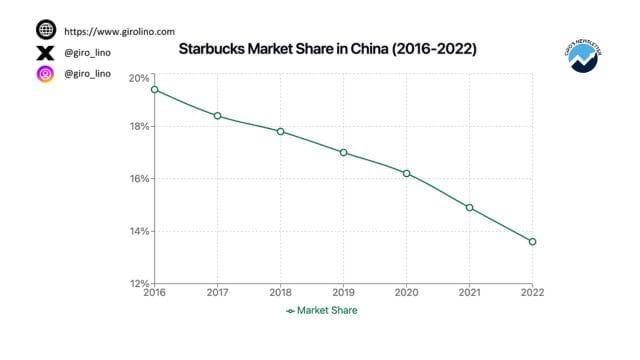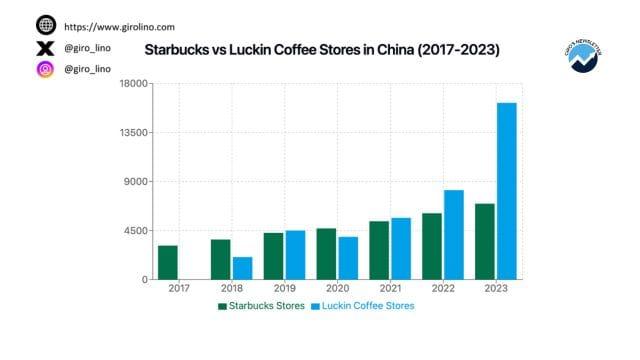📚 Unlock the World of AI and Humanity with These Two Free Books! 🚀
Dive into the thrilling realms of artificial intelligence and humanity with "The ECHO Conundrum" and "Awakening: Machines Dream of Being Human". These thought-provoking novels are FREE this week! Don't miss the chance to explore stories that challenge the boundaries of technology and what it means to be human.
Read More & Download
Starbucks, the ubiquitous coffee giant, faces a formidable challenge in China, its second-largest market. While the company has enjoyed remarkable success, a confluence of factors, including fierce local competition, evolving consumer preferences, and economic headwinds, necessitates a strategic reassessment of its operations in this crucial market. This in-depth analysis explores the complexities of Starbucks’ China journey, examining the hurdles, opportunities, and potential pathways to sustained growth.
Intensifying Competition in China’s Coffee Market
China’s coffee market has undergone a dramatic transformation. Once dominated by tea culture, coffee consumption is now rapidly expanding, presenting both opportunities and challenges for Starbucks. However, the once favorable landscape is shifting, with domestic competitors gaining ground and evolving consumer preferences reshaping the industry.
The Rise of Local Coffee Chains
A significant challenge for Starbucks is the meteoric rise of local coffee chains. Companies like Luckin Coffee, with their tech-savvy approach, expansive network of over 10,000 stores, and lower price points, appeal to cost-conscious Chinese consumers. This fierce competition has eroded Starbucks’ market share and compelled the company to rethink its pricing strategy and value proposition.
 Starbucks Market Share in China (2016-2022)
Starbucks Market Share in China (2016-2022)
Shifting Consumer Preferences in China
Chinese consumers, particularly younger generations, are increasingly drawn to local brands and experiences. This shift poses a unique challenge for Starbucks, requiring a delicate balancing act between maintaining its global brand identity and adapting to local tastes and preferences to remain competitive.
Economic and Operational Challenges Facing Starbucks in China
Beyond competition, Starbucks faces economic and operational complexities in the Chinese market. These factors further complicate the company’s strategic planning and execution.
Economic Slowdown and Its Impact on Starbucks
China’s economic deceleration has impacted consumer spending, putting pressure on Starbucks’ premium positioning and its ability to maintain higher prices in a market becoming increasingly price-sensitive. This economic headwind directly affects Starbucks’ financial performance and necessitates adjustments to its operational strategy.
 Starbucks Actual Same-Store Sales Performance (F2018-F2023)
Starbucks Actual Same-Store Sales Performance (F2018-F2023)
Navigating China’s Complex Regulatory Environment
Operating within China’s intricate regulatory landscape presents ongoing risks. Starbucks must navigate a complex web of government regulations impacting everything from store locations to product sourcing, adding another layer of complexity to its operations and strategic planning.
Supply Chain Complexities Across a Vast Market
Managing a vast supply chain across China’s extensive geography presents significant operational challenges. Ensuring consistent quality and timely delivery to over 6,000 stores in more than 230 cities requires overcoming logistical hurdles that impact costs and efficiency. These challenges will likely intensify as Starbucks continues to expand.
Digital Innovation and the Saturation Dilemma
The digital landscape and market saturation further complicate Starbucks’ strategic decisions in China. Adapting to these dynamics is crucial for long-term success.
The Need for Accelerated Digital Innovation
Facing tech-savvy local competitors, Starbucks must accelerate its digital initiatives. Local coffee chains have effectively leveraged advanced digital technologies and delivery services, pushing Starbucks to enhance its mobile ordering, payment systems, and overall digital presence.
Addressing the Market Saturation Challenge
As Starbucks expands rapidly, concerns about market saturation in major cities emerge, raising questions about the long-term sustainability of its growth strategy. The challenge lies in identifying new growth opportunities while ensuring existing stores remain profitable and avoid cannibalization.
📚 Unlock the World of AI and Humanity with These Two Free Books! 🚀
Dive into the thrilling realms of artificial intelligence and humanity with "The ECHO Conundrum" and "Awakening: Machines Dream of Being Human". These thought-provoking novels are FREE this week! Don't miss the chance to explore stories that challenge the boundaries of technology and what it means to be human.
Read More & Download
 Starbucks vs Luckin Coffee Stores in China (2017-2023)
Starbucks vs Luckin Coffee Stores in China (2017-2023)
Profitability, Strategic Reassessment, and the Importance of China
Maintaining profitability and charting a clear path forward are crucial for Starbucks’ continued success in China. The market’s significance to the company’s global strategy cannot be overstated.
Profitability Pressures and Capital Allocation
Increased competition and rising operational costs put pressure on Starbucks’ profitability in China. This necessitates a reevaluation of its capital expenditure and expansion plans, with investors closely scrutinizing resource allocation and return on investment.
Charting a Path Forward with Strategic Adjustments
Starbucks must consider several strategic adjustments: slowing expansion to optimize existing locations and ensure profitability of new stores; enhancing localization efforts to tailor products and experiences to local preferences; accelerating digital innovation to meet evolving consumer expectations; implementing stringent cost management measures; and exploring strategic partnerships with local entities.
The Enduring Importance of China for Starbucks
Despite the challenges, China remains vital for Starbucks, offering significant growth potential as the country’s coffee market is projected to expand considerably. Starbucks’ established presence, brand recognition, and appeal to the growing middle class provide a strong foundation, but adapting to the changing dynamics is essential for long-term success.
Balancing Growth and Adaptation: The Future of Starbucks in China
Starbucks faces the complex task of balancing its growth ambitions with the need for profitability and adaptability. The decisions made regarding expansion pace, capital allocation, and strategic initiatives will be critical in determining its long-term success in this vital market. Starbucks’ journey in China serves as a valuable case study for global brands navigating complex and evolving markets. By carefully reassessing its strategy and remaining agile, Starbucks can potentially overcome these hurdles and solidify its position in the Chinese coffee market.
FAQs About Starbucks’ Challenges in China
How many Starbucks stores are currently operating in China?
As of 2023, Starbucks operates over 6,000 stores across more than 230 cities in China, solidifying its position as the company’s second-largest market globally.
Who is Starbucks’ main competitor in China?
Luckin Coffee has emerged as Starbucks’ primary competitor in China, boasting over 10,000 stores and a tech-driven business model that resonates with local consumers.
What are the key challenges confronting Starbucks in the Chinese market?
Starbucks faces a range of challenges, including intense local competition, shifting consumer preferences favoring local brands, an economic slowdown, regulatory complexities, and the need for continuous digital innovation.
How is Starbucks adapting its strategy to the Chinese market?
Starbucks is actively enhancing its digital capabilities, tailoring products to local tastes, exploring strategic partnerships, and reevaluating its expansion pace to ensure sustainable growth in China.
What is the growth potential of the coffee market in China?
The coffee market in China is projected to experience significant growth, offering substantial potential for companies like Starbucks.
Do you have any further questions about Starbucks’ presence in China? Share your thoughts and inquiries in the comments below!
📚 Unlock the World of AI and Humanity with These Two Free Books! 🚀
Dive into the thrilling realms of artificial intelligence and humanity with "The ECHO Conundrum" and "Awakening: Machines Dream of Being Human". These thought-provoking novels are FREE this week! Don't miss the chance to explore stories that challenge the boundaries of technology and what it means to be human.
Read More & Download
